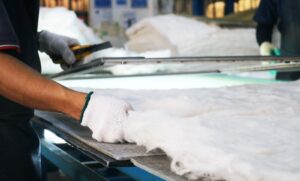How to Get Yellow Stains Out of a Mattress: Step-by-Step
- Large yellow stains on a mattress are typically caused by the buildup of sweat and body oils over time.
- Pre-treating your mattress with a sprinkling of baking soda can refresh its surface.
- Applying a cleaning solution with hydrogen peroxide, water, and soap along with another round of baking soda can help get rid of yellow stains.
- Products designed for upholstery cleaning may eliminate or reduce yellow discoloration.
- Using a mattress protector and being proactive about cleaning your bedding can help prevent yellow stains from developing.
With decades of combined experience with sleep products, our testing team has seen just about everything when it comes to mattresses. That includes seeing how a pristine mattress can develop large, yellow stains.
In this case, we’re not talking about urine stains (though we do have a guide for helping you fight urine stains if you need it). Instead, we’re referring to the patchy yellowing that develops with time, use, and exposure to sweat and body oils.
Because these yellow stains build up over time, you may not realize how bad they are until they’re already deeply discoloring your mattress. That being said, you can still clean them up and make your mattress look and smell fresher.
We’ll walk you through what causes yellow stains on a mattress, our favorite techniques for getting rid of yellow mattress (and pillow) stains, and share some of our practical tips for keeping your mattress clean.
What Are Yellow Mattress Stains?
Yellow mattress stains are discolorations caused mainly by sweat and oxidation of body oils that accompany the aging of the mattress materials.
When you sleep on the same mattress night after night, sweat can accumulate and start to leave a yellowish stain. This is just like the yellowing that you may find around the armpit of a well-worn shirt.
Additionally, body oils can seep into a mattress during sleep. As those oils are exposed to oxygen, they slowly oxidize, leaving a yellow or rust-colored stain. Sweat, dust, and humidity can contribute to this staining, leading to more extensive or darker yellow spots.
Yellow mattress stains tend to be larger and cover more surface area than spot stains. As you might suspect, yellow stains tend to be concentrated in the areas most in contact with your body. As a result, you’re less likely to see them around the edges of the mattress.
Not every person or every mattress develops these stains at the same rate. How much you sweat, how much your sweat and body oils are absorbed by your sheets, the type of fabric in the mattress cover, and the temperature and humidity of your bedroom can all influence how yellow stains form.
Pre-Clean: How to Prepare
Note: Don’t use bleach or harsh cleaning agents to clean your mattress, since they can be harmful to people and pets and also damage your mattress.
Before you roll up your sleeves and start taking on yellow mattress stains, there are a few pre-cleaning steps that can help you get everything ready.
- See if there’s a removable cover: Check if there’s a removable cover, which may allow you to easily wash the stained part of your mattress in the washer and dryer. Before removing a mattress cover, double-check that the manufacturer explicitly says the cover is safe to remove. Some covers have zippers and may look removable, but are not meant to be removed. Removing a cover you’re not meant to remove can potentially void the warranty, damage the mattress, or expose you to inner components of a mattress that you aren’t meant to touch.
- Remove all bedding: Strip your bed of all pillows, sheets, and blankets. If you haven’t washed them recently, this is a good opportunity to freshen them up.
- Check the positioning of your mattress: Make sure you can easily reach the stained parts of your mattress. If needed, pull your mattress away from the wall to get better access.
- Promote ventilation: You may want to crack a window or turn on a fan to a low setting to help with airflow through your bedroom.
- Consider grabbing gloves and a mask: Although you won’t be working with abrasive cleaners, you might want to use gloves and a mask if you have asthma or sensitive skin.
- Protect your bedroom floor and furniture: If you’re worried about dust or cleaning materials getting on your nightstand or bedroom floors, cover them up with a tarp or sheet.
- Vacuum your mattress: Give the entire mattress surface a once-over with the upholstery attachment of your vacuum to eliminate any top layer of dust or dirt.
In total, these steps shouldn’t take more than 10 or 15 minutes, so you can quickly proceed to the stain-removal process.
How to Get Yellow Stains Out of a Mattress: Step-by-Step
While there are many ways of cleaning a mattress, our team has found that two specific methods are most effective for yellow stains.
Cleaning With Hydrogen Peroxide and Baking Soda
What you’ll need to get yellow stains out with the hydrogen peroxide and baking soda method:
- Vacuum
- Water
- Dish soap (a clear soap is best)
- Baking soda
- Hydrogen peroxide
- An empty spray bottle
- A stiff brush or toothbrush
- Clean hand towels, rags, or paper towels
Caution: You’ll want to test your cleaning solution on a small part of the mattress. Start small and try to only use as much as you need. Hydrogen peroxide is good at removing yellow stains, but it can damage some fabrics.
After you’ve gotten everything together, follow this process to treat the yellow stains:
- Step 1: Make the cleaning solution. Mix 8 fluid ounces of cool water, 8 fluid ounces of hydrogen peroxide, and 2 or 3 drops of clear dish soap. Add this to the spray bottle. If you’re cleaning a smaller stain, you can reduce the total solution using the same ratios.
- Step 2: Sprinkle baking soda. Put a thin layer of baking soda over the entire stained area. Let it stand for at least 15 minutes.
- Step 3: Vacuum. Clear away all the baking soda.
- Step 4: Apply the cleaning solution. Spray the solution on top of all the yellow stains. The mattress should feel a bit damp but not soaking wet.
- Step 5: Reapply baking soda. Sprinkle baking soda over all of the areas where you sprayed the cleaning solution. Allow this to sit for at least a few hours, and, if possible, overnight.
- Step 6: Brush. Use your brush to go over the stained areas, working in the baking soda to help lift out the stains.
- Step 7: Vacuum and wipe down your mattress. Use your vacuum to remove the loose baking soda. Take a slightly damp rag and wipe down your mattress. Then wipe it down with a dry rag. If there is still loose baking soda, vacuum the mattress again.
- Step 8: Repeat as necessary. Check how much of the yellow staining was removed. For persistent stains, you may need to repeat steps 4 through 7.
- Step 9: Air dry. Allow your mattress to dry before putting any bedding back on.
Using a Store-Bought Upholstery Cleaner
For cleaning yellow stains using an upholstery cleaner, you’ll need to get a few items together:
- Vacuum
- Baking soda
- Store-bought upholstery cleaner, such as an enzyme cleaner
- Clean hand towels, rags, or paper towels
- Step 1: Apply baking soda. Sprinkle baking soda over the yellow stains, and let it sit for at least 15 minutes.
- Step 2: Vacuum. Thoroughly vacuum up all the baking soda.
- Step 3: Apply upholstery cleaner. Follow the instructions on the bottle. In most cases, this will involve applying the cleaner, letting it sit, and then wiping down the mattress with a rag.
- Step 4: Repeat as necessary. Look at the stains and do another round of cleaning if needed. Let your mattress dry out completely afterward.
How to Get Yellow Stains Out of a Pillow: Step-by-Step
If you need to wash a pillow, you should start by looking at its tag or checking the manufacturer’s instructions to see if it can be machine-washed. Some pillows are safe to put in the washer and dryer, which can be a quick and easy way to eliminate stains. Make sure to only use the washer and dryer settings listed on the pillow’s tag.
When machine-washing isn’t an option, you can remove yellow stains from a pillow by following the same step-by-step process for mattresses that we walked you through above. That being said, you may want to put in some extra effort to get rid of any smells that have built up in your pillow along with the stain. The sweat and oils that make up yellow stains can seep into your pillow and leave an odor, even if the outside of your pillow looks cleaned.
Use an Essential Oil While Cleaning
Using our hydrogen peroxide and baking soda method, you can add a few drops of an essential oil into the cleaning solution along with the water, hydrogen peroxide, and dish soap. The scent of the essential oil will help fight any lingering smells in the pillow. Just make sure you pick a safe essential oil with a relaxing smell since you’ll be sleeping on the pillow at night.
Make an Essential Oil Spray
Another way to freshen up the smell of your pillows is by creating an essential oil spray. In an empty spray bottle, add the following ingredients:
- ¼ cup of rubbing alcohol
- 1 cup of filtered or distilled water
- Up to 30 total drops of one or more essential oils
Shake the bottle to mix everything well, and then very lightly spritz your pillow with the mixture after you’ve removed the stains. You can also use this spray as a general smell freshener in your bedroom.
While these methods can really help at fighting a pillow’s smell, they won’t work in every situation. If the odor in your pillow is too strong, the old pillow smell comes back too quickly, or your pillow is more than a few years old, it may be time for a new pillow. You may not need to rush to get a new pillow, but it’s important to start looking for one before it becomes a problem.
How to Protect Your Mattress From Yellow Stains
To avoid having to deep clean your mattress, you can take a few steps to prevent yellow stains.
The easiest way is to use a mattress protector, which can be as simple as a thin mattress pad that creates a barrier between your sheets and the mattress. But for more heavy-duty protection, you can get a waterproof mattress encasement that will keep out sweat and body oils, along with other liquids.
If you don’t use a mattress protector, you can try adjusting your bedroom temperature or using lighter bedding to reduce sweating during the night. You should also make sure to wash your sheets frequently – roughly once a week – and check for stains anytime you change the sheets.
To freshen up your mattress, you can occasionally spread baking soda over the mattress surface, let it sit for 15 minutes or more, and then vacuum it up. If you ever notice stains forming, take action quickly to keep them from building up and being harder to clean later.
If you’re in the market for a new mattress, you can also look for one that has a removable and washable cover, so it’s easier to clean stains as they start to form. Like we mentioned above, make sure the manufacturer clearly states it is safe to remove your mattress cover, even if it has a zipper or looks removable. You can run the risk of voiding your warranty, damaging your mattress, or exposing yourself to parts of the mattress you aren’t meant to touch if you remove a cover without checking that it’s safe first.

Still have questions? Ask our community!
Join our Sleep Care Community — a trusted hub of product specialists, sleep health professionals, and people just like you. Whether you’re searching for the perfect mattress or need expert sleep advice, we’ve got you covered. Get personalized guidance from the experts who know sleep best.











